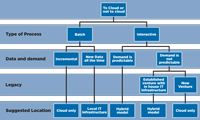In-Depth
Cloud vs. WAN Costs: A Breakdown
Researchers show the trend for cloud computing vs. on-premise costs.
More on this topic from Redmondmag.com:
One of the most famous Microsoft researchers was a man named Jim Gray. Gray spearheaded many projects, including work on the World-Wide Telescope that gathers all of the world's astronomy information into a single place. He had a similar ambition to build a digital library to contain the world's body of scientific knowledge. Gray was lost at sea off the California coast in 2007.
In 2003, Gray penned a paper called "Distributed Computing Economics," which asked whether it was more cost-effective to compute locally or reach across the network to powerful remote or distributed systems. His conclusion? If the distributed computing system is working on huge problems, problems that sometimes require days, months or even years of data processing, then the cost of sending the data over the network isn't so consequential. On the other hand, most problems can be easily handled locally and it's a waste of money to send them across the network. In Gray's analysis, keeping computers as close to applications as possible made the most sense.

[Click on image for larger view.] |
| A Cloud Adoption Decision Tree |
In 2009, 11 computer academics at the University of California, Berkeley, redid Gray's numbers. It turns out the costs for storage and servers have fallen faster than that of network connections. The numbers are dramatic. WAN costs fell by a factor of 2.7x. Sounds pretty good. But computational equipment fell by a stunning 16 times.
|
WAN Bandwidth/mo. |
CPU Hours (All Cores) |
Disk Storage |
| Items in 2003 |
1Mbps WAN link |
2GHz CPU, 2GB DRAM |
200GB disk, 50 Mb/s transfer rate |
| Cost in 2003 |
$100/mo. |
$2,000 |
$200 |
| $1 buys in 2003 |
1GB |
8 CPU hours |
1 GB |
| Item in 2008 |
100 Mbps WAN link |
2GHz, 2 sockets, 4 cores/socket, 4GB DRAM |
1TB disk, 115MB/sustained transfer |
| Cost in 2008 |
$3,600/mo. |
$1,000 |
$100 |
| $1 buys in 2008 |
2.7GB |
128 CPU hours |
10GB |
| Cost/Performance Improvement |
2.7x |
16x |
10x |
| Cost to Rent $1 Worth on AWS in 2008 |
$0.27-$0.40 ($0.10-$0.15/GB x 3 GB) |
$2.56 (128 x 2 VMs@$0.10 each) |
$1.20-$1.50 ($0.12-$0.15/GBmonth x 10GB) |
| Source: University of California, Berkeley, Electrical Engineering and Computer Sciences Division |
Table 1. WAN vs. Computation Costs
|
This math didn't lead Berkeley's researchers to find that on-premises computing is the most economically efficient model. In fact, they reached the opposite opinion -- that the cloud is cheaper in most cases.
With on-premises systems, you have to buy enough gear to handle peak traffic rates that may only occur rarely. And your average need may change over time as your business grows or shrinks.
On the other hand, the cloud is elastic, so you only pay for what you need, and usage can go up or down radically without hardware investment. This elasticity allows IT to shift the economic risk of hardware investment to the services provider.
And big jobs can be done faster and cheaper. Let's say you have a job that requires 1,000 hours on a single server. With the cloud, you can buy one hour's access to 1,000 servers. Job done!
Ultimately, IT has to decide if the cloud makes economic sense. "You have to consider all factors when moving to cloud. You can write off all your assets and go to a fixed monthly cost -- no more expensive equipment on the company books. If you design your cloud environment correctly, you shouldn't see that much more cost for bandwidth," Cloud Consultant Mike Goodenough explains.
About the Author
Doug Barney is editor in chief of Redmond magazine and the VP, editorial director of Redmond Media Group.